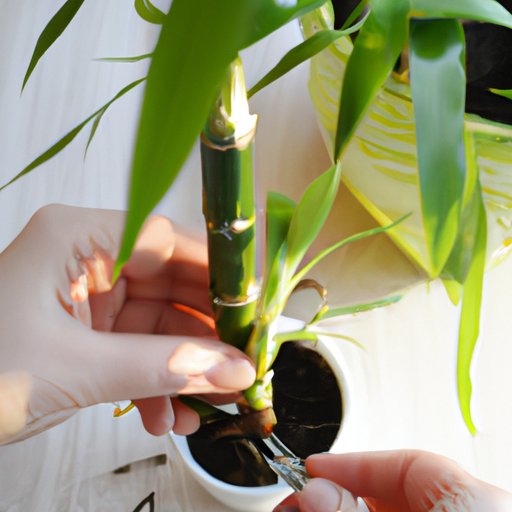Introduction
Bamboo plants are a popular choice for indoor gardens due to their unique look and easy maintenance. These evergreen plants come in a variety of shapes and sizes, making them perfect for any home décor. In addition to being aesthetically pleasing, bamboo plants offer a number of health benefits such as improving air quality, reducing stress, and creating a calming atmosphere. With proper care and attention, you can keep your bamboo plant looking its best for years to come.

Choose the Right Potting Soil
When it comes to caring for a bamboo plant, the right potting soil is essential. Bamboo plants thrive in well-draining, slightly acidic soil that is rich in organic matter. Look for a potting mix that is specifically designed for bamboo plants or use a combination of one part peat moss, one part compost, and one part perlite. Make sure the soil is moist but not soggy before planting.
Provide Adequate Sunlight
Bamboo plants need bright, indirect light to thrive. Place your bamboo plant in an area with plenty of natural light, such as near a window. If you’re unable to provide enough natural light, you can supplement with artificial lighting such as grow lights. Be careful not to place your plant in direct sunlight, as this can cause the leaves to burn.
Water Regularly
Bamboo plants need to be watered regularly to stay healthy. Water your bamboo plant once a week, making sure the soil is moist but not soggy. During the summer months, you may need to water more frequently. Avoid overwatering, as this can lead to root rot. Allow the top inch of soil to dry out between waterings.
Fertilize Monthly
Fertilizing your bamboo plant will help promote healthy growth and vibrant foliage. Use a balanced fertilizer formulated for bamboo plants, such as a 10-10-10 or 8-8-8 blend. Apply the fertilizer every month during the spring and summer growing season. Follow the instructions on the package for the correct amount to apply.

Prune Away Dead or Dying Leaves
It’s important to remove any dead or dying leaves from your bamboo plant to maintain a healthy look. Prune away any brown or yellow leaves as soon as you notice them. This will help encourage new growth and keep your plant looking its best. Be sure to use sharp, clean scissors when pruning.
Check for Pests and Treat if Necessary
Pests can be a major problem for bamboo plants. Common pests to watch out for include mealybugs, scale, and spider mites. If you notice any signs of infestation, take immediate action. You can treat the problem with an insecticidal soap or horticultural oil. Be sure to follow the instructions on the product to ensure safe and effective use.
Repot When Needed
Your bamboo plant may need to be repotted periodically to ensure that it has enough room to grow. Repot your bamboo plant every two to three years, using a pot that is one size larger than the previous one. Make sure to use fresh potting soil and gently loosen the roots before transferring the plant to the new pot.
Conclusion
Caring for a bamboo plant at home is relatively easy with the right knowledge and supplies. Choose the right potting soil, provide adequate sunlight, water regularly, fertilize monthly, prune away dead or dying leaves, check for pests and treat if necessary, and repot when needed. With these steps, you can keep your bamboo plant looking its best for years to come.
(Note: Is this article not meeting your expectations? Do you have knowledge or insights to share? Unlock new opportunities and expand your reach by joining our authors team. Click Registration to join us and share your expertise with our readers.)
